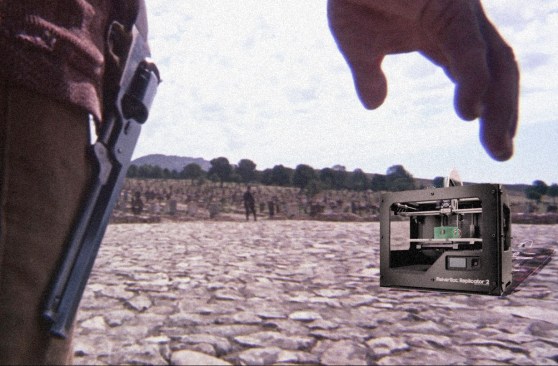If you’re trying to understand how existing intellectual property law applies to 3D printing, let me save you some time: It’s a complete mess.
From top to bottom, 3D printing raises more legal questions than it answers. There are lots of companies making 3D printing hardware, even more companies offering online repositories of 3D designs, plenty of services that will print things for you, and almost zero precedent for disputes among them. From a legal standpoint, 3D printing is the Wild West.
While that may sound liberating for such a young industry, it’s also potentially dangerous. There’s a very real chance that the lack of any regulation could be replaced with bad regulation. And that could have some dire effects on the whole industry.
“Copyright precedents are created one case at a time, and eventually they can lead to the accretion of copyright expansion in a way that was never intended,” Public Knowledge attorney Michael Weinberg said.
Bad laws, Weinberg says, emerge out of a basic misunderstanding of how industries work. And for a young technology like 3D printing, misunderstandings are going to be common.
How bad could it get? Consider a law that would force companies like MakerBot and 3D Systems to shell out a percentage of their sales to offset the piracy factor, with the money going into a fund to compensate makers of plastic toys, like Mattel and Disney. Or a law that required 3D services to adopt software that limits the number of times 3D design files (STLs, etc) can be printed or which printers can print them.
For people who are excited about free, unfettered access to 3D printer technology, those are some scary possibilities. But Weinberg is convinced that 3D printers, on the whole, will come out all right.
“These are general-purpose machines, and the companies that make them are fairly well-protected,” he said.
Copying, printing, infringing
Right now there are quite a few sites that act as repositories for 3D designs. MakerBot’s Thingiverse, Shapeways, and i.materialise all invite people to upload their designs and share them with (or sell them to) others.
But once you let people upload their own files, you expose yourself to all of the risks that come with that freedom, such as files that infringe on copyrights. (Consider all of those Yoda figures that Star Wars fans like to put on Thingiverse, for example.)
These sites handle copyright concerns the same way YouTube does: Copyright holders post takedown notices, and the hosting sites, as protected “safe havens” under the Digital Millennium Copyright Act (DMCA), cover their butts by taking the infringing files down. Simple enough.
Sometimes the process is a bit more complicated, though. Thingiverse hit a major milestone in February 2011, when it got its very first takedown request. The complaint came from Ulrich Schwanitz, a designer who claimed that a Thingiverse user had uploaded “his” design to the site without his permission. The problem? The design in question was a model of the Penrose Triangle, created in 1934.
Community response to Schwanitz’s claims was, suffice it to say, not glowing (“Ulrich Schwanitz is an ass,” a Thingiverse commenter eloquently quipped), and Schwanitz eventually dropped his infringement claims and donated the design to the public domain.
Another example: Earlier this month, 3DLT, a 3D design marketplace, posted designs on its site without the permission of the design owner. 3DLT eventually blamed the problem on sample listings that went live before they were supposed to, but the damage was already done: 3DLT was forced to give a public apology and reaffirm its commitment to protecting the intellectual property of all designers — not just its own.
“3DLT is committed to providing a consumer-friendly, 3D design marketplace where creative assets are safely protected and designers are properly compensated for their intellectual property,” the company said in a statement to VentureBeat.
But while Thingiverse and 3DLT are already dealing with IP issues, Todd Grimm, president of consulting firm T. A. Grimm & Associates, says that the concerns over 3D printing are, at this point, overstated.
“That future of consumers making their own designs and firing up their personal 3D printers to pirate objects is years, or even decades away,” he said.
Unlike most people who pay attention to 3D printing, Grimm isn’t convinced about the technology’s short-term potential to disrupt, say, the kids toys or spare car parts industries. And neither, he says, are the industries themselves.
“Honestly, most companies may not even be afraid of it. They’re really not thinking of this now,” he said.
The pirates discover 3D printing
Companies may not be paying close attention, but the days when physical objects can be pirated as easily as Weezer songs are coming, and the Pirate Bay is already pushing things along.
Last year the torrent site launched its “physibles” category, which hosts STL designs that 3D printer users can print out. Right now the category only houses a hundred or so files, and they’re limited to things like gun parts, Guy Fawkes masks, and printable copies of records like Pink Floyd’s “The Dark Side of the Moon.” The early days of pirated objects are, well, subdued.
It won’t always be this way, of course, and it’s only a matter of time until the piracy of physical objects will be as common as the piracy of music and movies is today.
How will companies handle this? That depends on how well they adjust to the realities of IP law.
Public Knowledge’s Michael Weinberg says one of the big challenges for all object industries will be to collectively recognize the realities of intellectual property as it relates to both digital and physical objects. The first step? Realizing that IP law is nowhere near as robust as we think it is.
“People assume that everything they sell is protected by IP, but that’s often not the case with physical things,” Weinberg said.
“Companies are going to have to recognize when they have legit claims and when they won’t — and most of the time, they won’t,” he added.
This is something established industries won’t like to hear, of course and, if history is any indication, most of them will react by firing their legal teams in all directions.
Weinberg, however, hopes that they won’t. The music and movie industries have already shown us what happens when fear drives ligation: Lots of people get sued, lots of money gets spent, and no one really has much to show for it.
Instead of suing the 3D printing industry, smart companies of the future are going to figure out how to profit from it.
VentureBeat's mission is to be a digital town square for technical decision-makers to gain knowledge about transformative enterprise technology and transact. Learn More



